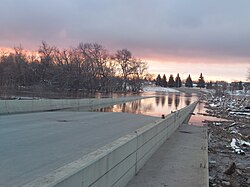This article includes a list of general references, but it lacks sufficient corresponding inline citations. (December 2015) |





A low-water crossing (also known as an Irish bridge or Irish Crossing, causeway in Australia, low-level crossing or low-water bridge) is a low-elevation roadway traversing over a waterbody that stays dry above the water when the flow is low, but is designed to get submerged under high-flow conditions such as floods. This type of crossing is much cheaper to build than a high bridge that keeps the road surface consistently above the highest water level, and is usually deployed in semi-arid areas where high-volume rainfall is rare and the existing channel is shallow (which requires extra ramping on the banks to build a more elevated bridge and thus costs more), particularly in developing countries.
Low-water crossings are essentially elevated floodways, functioning like causeways under normal conditions and serving as limited fords during high-discharge conditions. They are generally considered unsafe for traffic during floods due to the potentially fast and turbulent currents flowing over the road surface, and can be dangerous even after the flood has receded because silt, mud and debris left on the road by the water can reduce traction and cause skidding risks for both vehicles and pedestrians.
In Japan, a Konnyaku bridge is a type of low-water crossing.